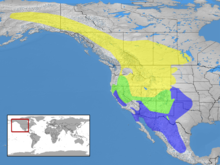| Mountain bluebird | |
|---|---|

| |
| Male | |

| |
| Female | |
| Scientific classification | |
| Domain: | Eukaryota |
| Kingdom: | Animalia |
| Phylum: | Chordata |
| Class: | Aves |
| Order: | Passeriformes |
| Family: | Turdidae |
| Genus: | Sialia |
| Species: | S. currucoides
|
| Binomial name | |
| Sialia currucoides (Bechstein, 1798)
| |

| |
Breeding range Year-round range Wintering range
| |
| Synonyms | |
The mountain bluebird (Sialia currucoides) is a migratory small thrush that is found in mountainous districts of western North America. It has a light underbelly and black eyes. Adult males have thin bills and are bright turquoise-blue and somewhat lighter underneath. Adult females have duller blue wings and tail, grey breast, grey crown, throat and back. In fresh fall plumage, the female's throat and breast are tinged with red-orange which is brownish near the flank, contrasting with white tail underparts. Their call is a thin 'few' while their song is a warbled high 'chur chur'. The mountain bluebird is the state bird of Idaho and Nevada. This bird is an omnivore and it can live 6 to 10 years in the wild. It eats spiders, grasshoppers, flies and other insects, and small fruits. The mountain bluebird is a relative of the eastern and western bluebirds.
- ^ BirdLife International (2019). "Sialia currucoides". IUCN Red List of Threatened Species. 2019: e.T22708556A137560639. doi:10.2305/IUCN.UK.2019-3.RLTS.T22708556A137560639.en. Retrieved 12 November 2021.
- ^ Swainson, William John; Richardson, J. (1831). Fauna boreali-americana, or, The zoology of the northern parts of British America. Vol. Part 2. The Birds. London: J. Murray. p. 209. The title page bears the year 1831 but the volume did not appear until 1832.
- ^ Lepage, Denis. "Mountain Bluebird". Avibase. Retrieved 11 September 2020.
